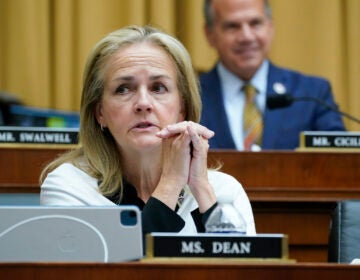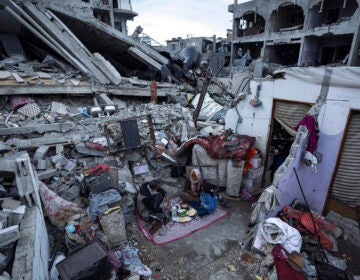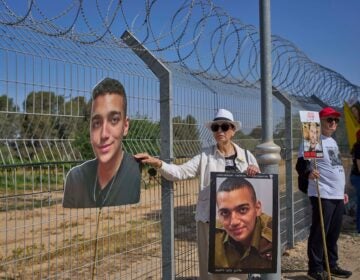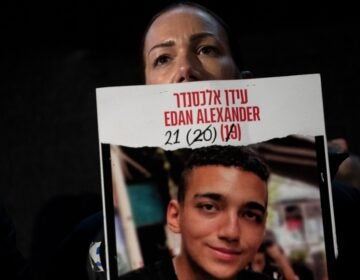Russia and China veto U.S. resolution calling for immediate cease-fire in Gaza
Israel faces mounting pressure from even its closest allies to streamline the entry of aid into the Gaza Strip, and come to a cease-fire agreement.
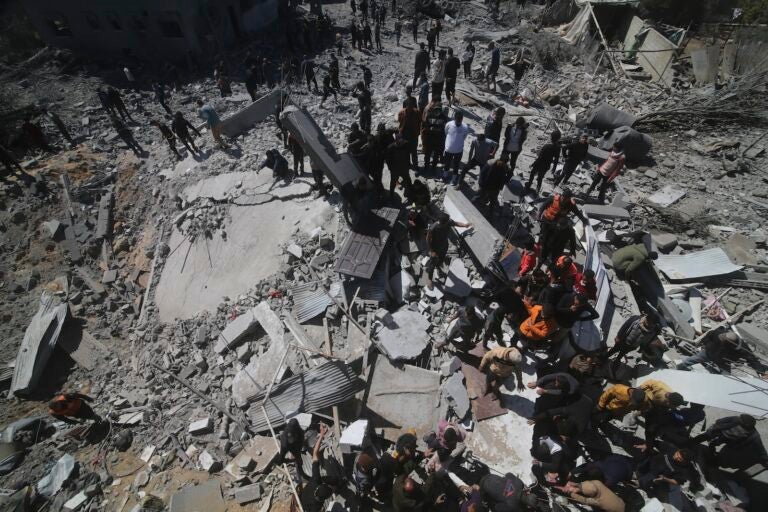
Palestinians look at a residential building destroyed in an Israeli strike in Rafah, Gaza Strip, Tuesday, March 20, 2024. (AP Photo/Hatem Ali)
Russia and China on Friday vetoed a U.S.-sponsored U.N. resolution calling for “an immediate and sustained cease-fire” in the Israel-Hamas war in Gaza to protect civilians and enable humanitarian aid to be delivered to more than 2 million hungry Palestinians.
The vote in the 15-member Security Council was 11 members in favor, three against and one abstention.
Before the vote, Russia’s U.N. Ambassador Vassily Nebenzia said Moscow supports an immediate cease-fire, but he questioned the language in the resolution and accused U.S. Secretary of State Antony Blinken and U.S. Ambassador Linda Thomas-Greenfield of “misleading the international community” for “politicized” reasons.
The resolution declared that a cease-fire is “imperative.”
The draft that was put to a vote made no direct link to the release of hostages taken during Hamas’ Oct. 7 attack on Israel, which was in the previous draft. But it unequivocally supported diplomatic efforts “to secure such a cease-fire in connection with the release of all remaining hostages.”
The Security Council had already adopted two resolutions on the worsening humanitarian situation in Gaza, but none calling for a cease-fire.
Russia and China vetoed a U.S.-sponsored resolution in late October calling for pauses in the fighting to deliver aid, protection of civilians, and a halt to arming Hamas. They said it didn’t reflect global calls for a cease-fire.
The U.S., Israel’s closest ally, has vetoed three resolutions demanding a cease-fire, the most recent an Arab-backed measure supported by 13 council members with one abstention on Feb. 20.
A day earlier, the U.S. circulated a rival resolution, which went through major changes during negotiations before Friday’s vote. It initially would have supported a temporary cease-fire linked to the release of all hostages, and the previous draft would have supported international efforts for a cease-fire as part of a hostage deal.
The vote took place as Blinken, America’s top diplomat, is on his sixth urgent mission to the Middle East since the Israel-Hamas war, discussing a deal for a cease-fire and hostage release, as well as post-war scenarios.
Nate Evans, the spokesperson for the U.S. Mission to the United Nations, said the resolution was “an opportunity for the Council to speak with one voice to support the diplomacy happening on the ground and pressure Hamas to accept the deal on the table.”
Meanwhile, the 10 elected members of the Security Council have been drafting their own resolution, which demands an immediate humanitarian cease-fire for the Muslim holy month of Ramadan that began March 10 to be “respected by all parties leading to a permanent sustainable cease-fire.”
It also demands “the immediate and unconditional release of all hostages ” and emphasizes the urgent need to protect civilians and deliver humanitarian aid throughout the Gaza Strip.
Palestinian militants killed some 1,200 people in the surprise Oct. 7 attack into southern Israel that triggered the war, and abducted another 250 people. Hamas is still believed to be holding some 100 people hostage, as well as the remains of 30 others.
In Gaza, the Health Ministry raised the death toll in the territory Thursday to nearly 32,000 Palestinians. It doesn’t differentiate between civilians and combatants in its count but says women and children make up two-thirds of the dead.
The international community’s authority on determining the severity of hunger crises warned this week that “famine is imminent” in northern Gaza, where 70% of people are experiencing catastrophic hunger. The report from the Integrated Food Security Phase Classification initiative, or IPC, warned that escalation of the war could push half of Gaza’s total population to the brink of starvation.
The U.S. draft expressed “deep concern about the threat of conflict-induced famine and epidemics presently facing the civilian population in Gaza as well as the number of undernourished people, and also that hunger in Gaza has reached catastrophic levels.”
It emphasized “the urgent need to expand the flow of humanitarian assistance to civilians in the entire Gaza Strip” and lift all barriers to getting aid to civilians “at scale.”
Israel faces mounting pressure from even its closest allies to streamline the entry of aid into the Gaza Strip and to open more land crossings, and come to a cease-fire agreement. But Prime Minister Benjamin Netanyahu has vowed to move the military offensive to the southern city of Rafah, where some 1.3 million displaced Palestinians have sought safety. Netanyahu says it’s a Hamas stronghold.
The final U.S. draft eliminated language in the initial draft that said Israel’s offensive in Rafah “should not proceed under current circumstances.” Instead, in an introductory paragraph, the council emphasized its concern that a ground offensive into Rafah “would result in further harm to civilians and their further displacement, potentially into neighboring countries, and would have serious implications for regional peace and security.”
For the first time in a U.N. resolution, the U.S. draft would condemn “all acts of terrorism, including the Hamas-led attacks of Oct. 7, 2023, as well as its taking and killing of hostages, murder of civilians, and sexual violence, including rape.”

Get daily updates from WHYY News!
WHYY is your source for fact-based, in-depth journalism and information. As a nonprofit organization, we rely on financial support from readers like you. Please give today.


